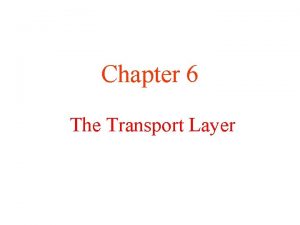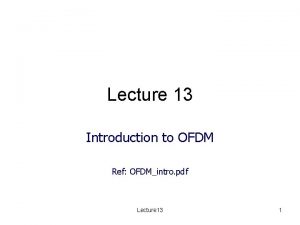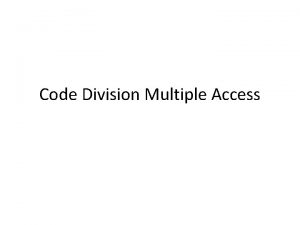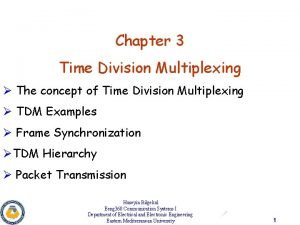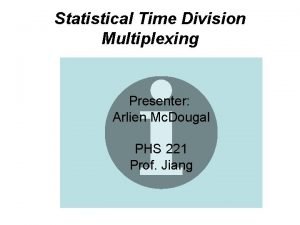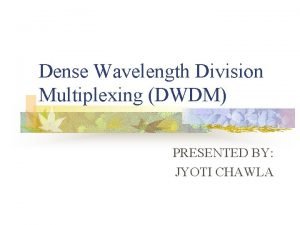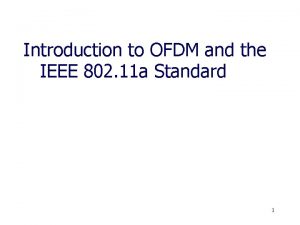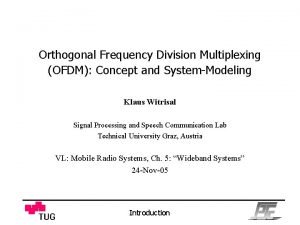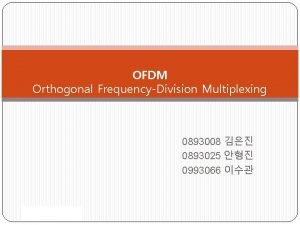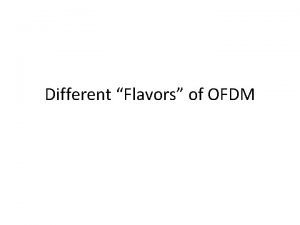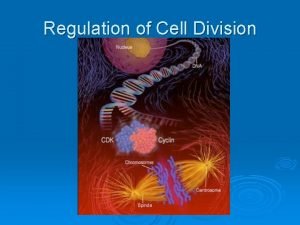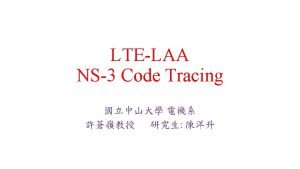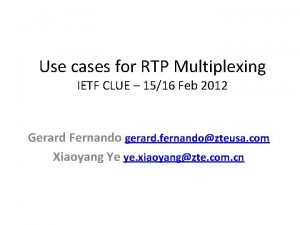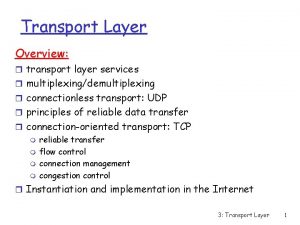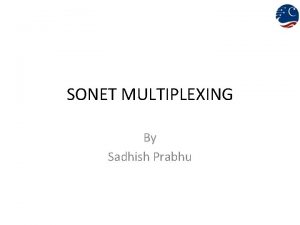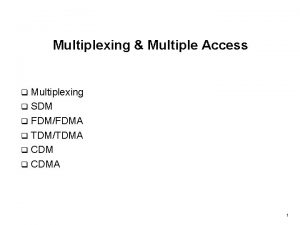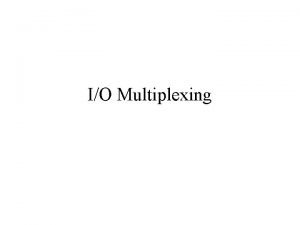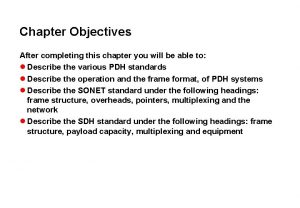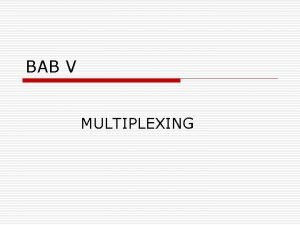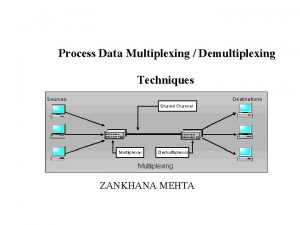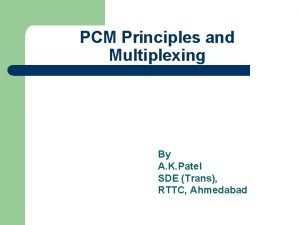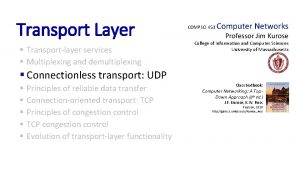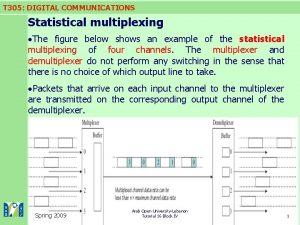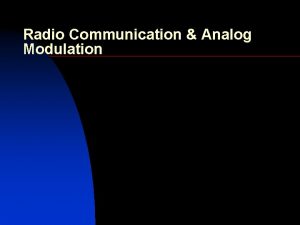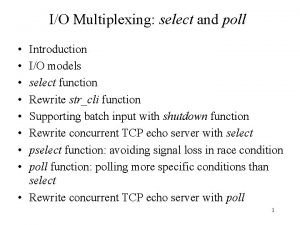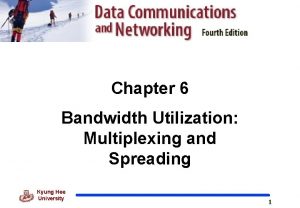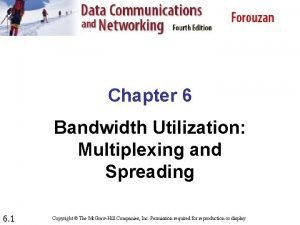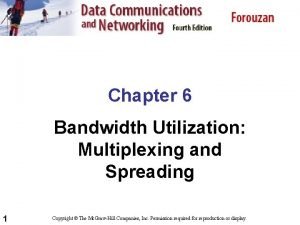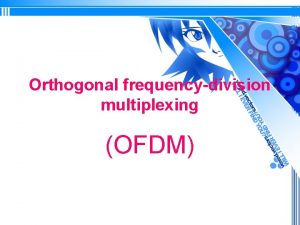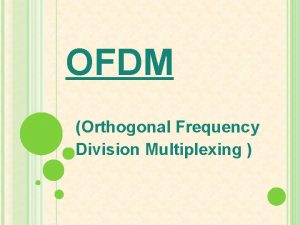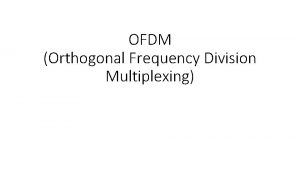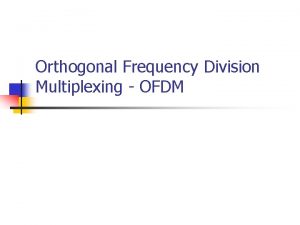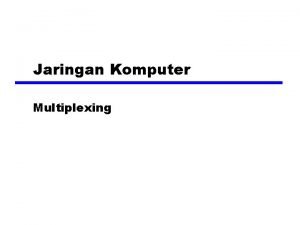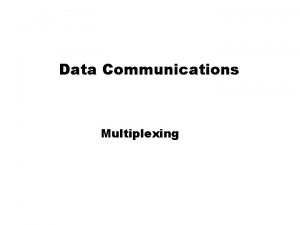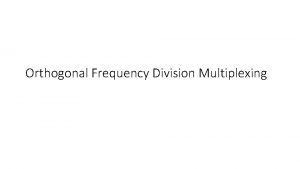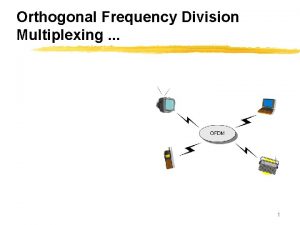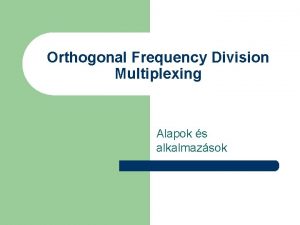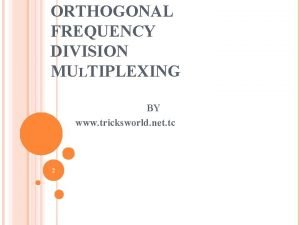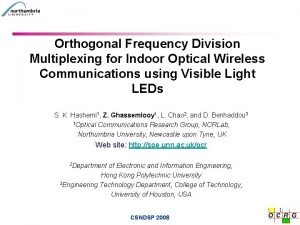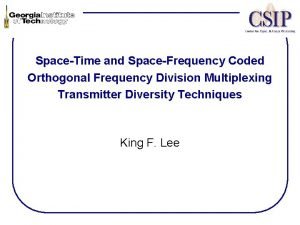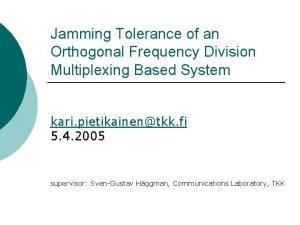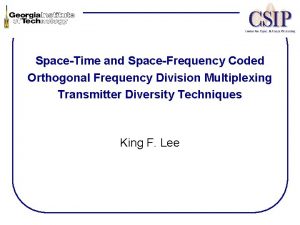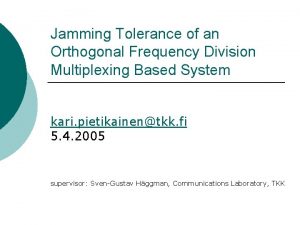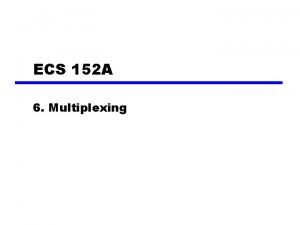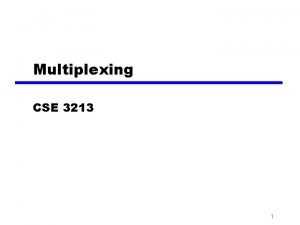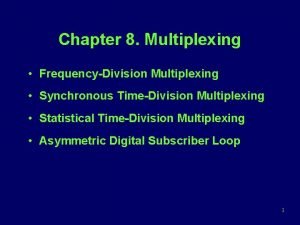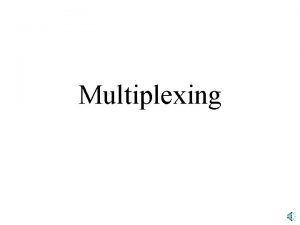IV Orthogonal Frequency Division Multiplexing OFDM Introduction Evolution










































- Slides: 42

IV. Orthogonal Frequency Division Multiplexing (OFDM)

Introduction Evolution of Wireless Communication Standards OFDM © Tallal Elshabrawy 2

Wireless Communication Channels From “Wireless Communications” Edfors, Molisch, Tufvesson l l l Communications over wireless channels suffer from multi-path propagation Multi-path channels are usually frequency selective OFDM supports high data rate communications over frequency selective channels © Tallal Elshabrawy 3

Multi-Path Propagation Modeling Power Multi-Path Components τ0 τ1 τ2 Time Multi-path results from reflection, diffraction, and scattering off environment surroundings Note: The figure above demonstrates the roles of reflection and scattering only on multi-path © Tallal Elshabrawy 4

Multi-Path Propagation Modeling Power Multi-Path Components τ0 τ1 τ2 Time As the mobile receiver (i. e. car) moves in the environment, the strength of each multi-path component varies © Tallal Elshabrawy 5

Multi-Path Propagation Modeling Power Multi-Path Components τ0 τ1 τ2 Time As the mobile receiver (i. e. car) moves in the environment, the strength of each multi-path component varies © Tallal Elshabrawy 6

Multi-Path = Frequency-Selective! f=0 0. 5 1 1 0. 5 1 μs f=1 MHz 1 0. 5 -1 0. 5 1 μs 1 0. 5 -1 1 μs 1 f=500 KHz -1 0. 5 1 μs 1 0. 5 -1 1 μs © Tallal Elshabrawy 7

Multi-Path = Frequency-Selective! h(t) |H(f)| 0. 5 1 f (MHz) 1 μs 0 0. 5 1 1. 5 2 l A multi-path channel treats signals with different frequencies differently l A signal composed of multiple frequencies would be distorted by passing through such channel © Tallal Elshabrawy 8

Frequency Division & Coherence Bandwidth Power Frequency l l l Subdivide widebandwidth into multiple narrowband subcarriers Bandwidth of each channel is selected such that each sub-carrier approximately displays Flat Fading characteristics The bandwidth over which the wireless channel is assumed to display flat fading characteristics is called the coherence bandwidth © Tallal Elshabrawy 9

Example Frequency Response for 3 G Channel Power Delay Profile (Vehicular A Channel Model) Resolv Relative able Delay Path (nsec) Average Power (d. B) 1 0 0. 0 2 310 -1. 0 3 710 -9. 0 4 1090 -10. 0 5 1730 -15. 0 6 2510 -20. 0 Snapshot for Frequency Response Simulation Assumptions l Rayleigh Fading for each resolvable path l System Bandwidth = 5 MHz l Coherence Bandwidth = 540 KHz l Number of Sub-Carriers = 64 l Sub-Carrier Bandwidth = 78. 125 KHz © Tallal Elshabrawy 10

Example Frequency Response for 3 G Channel Power Delay Profile (Vehicular A Channel Model) Resolv Relative able Delay Path (nsec) Average Power (d. B) 1 0 0. 0 2 310 -1. 0 3 710 -9. 0 4 1090 -10. 0 5 1730 -15. 0 6 2510 -20. 0 Snapshot for Frequency Response Simulation Assumptions l Rayleigh Fading for each resolvable path l System Bandwidth = 5 MHz l Coherence Bandwidth = 540 KHz l Number of Sub-Carriers = 64 l Sub-Carrier Bandwidth = 78. 125 KHz © Tallal Elshabrawy 11

Frequency Division Multiplexing (FDM) Binary Encoder Transmitting Filter (f 1) Modulation Bandpass Filter (f 1) Demod. Binary Encoder Transmitting Filter (f 2) Modulation Bandpass Filter (f 2) Demod. Bandpass Filter (f. N) Demod. + Binary Encoder © Tallal Elshabrawy Transmitting Filter (f. N) Modulation Wireless Channel

Channel Bandwidth of FDM Time-Limited Communications Tx Filter Band-Limited Communications Rectangular Filter Raised Cosine Filter TS Tx Signal in Time TS Tx Signal in Frequency 2/TS 0 -fc Signal Bandwidth © Tallal Elshabrawy fc Zero-to-Zero Bandwidth = 2/TS -fc- RS/2 -fc+ RS/2 0 fc- RS/2 fc+ RS/2 Bandwidth = RS = 1/TS 13

Orthogonal FDM Is it possible to find carrier frequencies f 1, f 2 … f. N such that © Tallal Elshabrawy 14

Orthogonal FDM Is it possible to find carrier frequencies f 1, f 2 … f. N such that © Tallal Elshabrawy 15

Orthogonality of Sub-Carriers Ts The sinusoid signals with frequencies f 1, f 2, f 3, f 4 are all mutually orthogonal over the symbol period Ts © Tallal Elshabrawy 16

Orthogonality of Sub-Carriers Ts The sinusoid signals with frequencies f 1, f 2, f 3, f 4 are all mutually orthogonal over the symbol period Ts © Tallal Elshabrawy 17

Orthogonality of Sub-Carriers Ts The sinusoid signals with frequencies f 1, f 2, f 3, f 4 are all mutually orthogonal over the symbol period Ts © Tallal Elshabrawy

Orthogonality of Sub-Carriers Ts The sinusoid signals with frequencies f 1, f 2, f 3, f 4 are all mutually orthogonal over the symbol period Ts © Tallal Elshabrawy

Orthogonality of Sub-Carriers Ts The sinusoid signals with frequencies f 1, f 2, f 3, f 4 are all mutually orthogonal over the symbol period Ts © Tallal Elshabrawy

Orthogonality of Sub-Carriers Ts The sinusoid signals with frequencies f 1, f 2, f 3, f 4 are all mutually orthogonal over the symbol period Ts © Tallal Elshabrawy

Orthogonality of Sub-Carriers Ts The sinusoid signals with frequencies f 1, f 2, f 3, f 4 are all mutually orthogonal over the symbol period Ts © Tallal Elshabrawy

Orthogonal FDM Binary Encoder Transmitting Filter (f 1) Modulation Correlate with (f 1) Demod. Modulation Correlate with (f 2) Demod. Correlate with (f. N) Demod. f 2=f 1+1/2 TS Binary Encoder Transmitting Filter (f 2) + Wireless Channel f. N=f 1+1/2(N-1)TS Binary Encoder © Tallal Elshabrawy Transmitting Filter (f. N) Modulation 23

Number of Subcarriers in OFDM l For band-limited FDM if the system bandwidth is B, number of sub-carriers is given by: l For OFDM if the system bandwidth is B, Number of sub-carriers is given by: OFDM has the potential to at least double the number of sub-carriers (i. e. , double the total transmission rate over the system bandwidth) © Tallal Elshabrawy 24

Intersymbol Interference in OFDM Assume OFDM over two subcarriers: f. T 1=1/T s s, f 2=2/Ts Ts + OFDM Symbol Tx Signal © Tallal Elshabrawy 25

Intersymbol Interference in OFDM Symbol Tx Signal Suppose multi-path channel with delay Ts/8 h 0 h 1 Ts/8 OFDM Symbol Inter-Symbol Interference (ISI) Rx Signal Inter-symbol interference (ISI) occurs when one OFDM symbol affects the next one due to the multi-path channel © Tallal Elshabrawy 26

Inserting Guard Time OFDM Symbol Tx Signal Ts/8 Ts Ts Ts/4 Guard Time Suppose multi-path channel with delay Ts/8 h 0 h 1 Ts/8 Rx Signal Guard Time l l l Ts Ts Ts/4 No ISI Guard Time eliminates ISI between neighboring OFDM symbols However each OFDM symbol suffers from inter-carrier interference (ICI) Guard time corresponds to a reduction of bit rate © Tallal Elshabrawy 27

Guard Time & Inter-Carrier Interference Rx Signal Tx Signal OFDM Symbol Ts/8 Ts Guard Time + © Tallal Elshabrawy OFDM Symbol + 28

Guard Time & Inter-Carrier Interference Rx Signal OFDM Symbol Ts/8 Consider the receiver for f 1=1/Ts that correlates over Ts with Ts Ts Guard Time Correlation at Rx over Ts Not Orthogonal x + Intra-Carrier Interference © Tallal Elshabrawy 29

Guard Time & Inter-Carrier Interference Rx Signal OFDM Symbol Ts/8 Consider the receiver for f 1=1/Ts that correlates over Ts with Ts Ts Guard Time Correlation at Rx over Ts Orthogonal x + No Interference © Tallal Elshabrawy 30

Guard Time & Inter-Carrier Interference Rx Signal OFDM Symbol Ts/8 Consider the receiver for f 1=1/Ts that correlates over Ts with Ts Ts Guard Time Correlation at Rx over Ts Not Orthogonal x + Inter-Carrier Interference © Tallal Elshabrawy 31

Cyclic Prefix The cyclic prefix is used to eliminate Inter-carrier interference Tx Signal (Guard Time) Tx Signal (Cyclix Prefix) OFDM Symbol Ts/8 Ts Cyclic Prefix Guard Time + Cyclic Prefix © Tallal Elshabrawy Ts/8

Cyclic Prefix Rx Signal (Cyclix Prefix) Cyclic Prefix Ts/8 Ts Consider the receiver for f 1=1/Ts that correlates over Ts with Ts/8 Correlation at Rx over Ts Ts Not Orthogonal + Intra-Carrier Interference © Tallal Elshabrawy x

Cyclic Prefix Rx Signal (Cyclix Prefix) Cyclic Prefix Ts/8 Ts Consider the receiver for f 1=1/Ts that correlates over Ts with Ts/8 Correlation at Rx over Ts Ts Orthogonal + No Interference © Tallal Elshabrawy x

Cyclic Prefix Rx Signal (Cyclix Prefix) Cyclic Prefix Ts/8 Ts Consider the receiver for f 1=1/Ts that correlates over Ts with Ts/8 Correlation at Rx over Ts Ts Orthogonal + No Inter. Carrier Interference © Tallal Elshabrawy x

Cyclic Prefix (Summary) Assume fi, fj are two OFDM sub-carriers and φij is the phase shift associated with the cyclic prefix and multi-path channel Cyclic Prefix eliminates Inter-carrier Interference (ICI) © Tallal Elshabrawy 36

Cyclic Prefix (Summary) Assume an OFDM sub-carrier fi, and φii is the phase shift associated with the cyclic prefix and multi-path channel With Cyclic Prefix remains the component cos φii as a source of Intra-Carrier Interference © Tallal Elshabrawy 37

Cyclic Prefix vs Guard Time Cyclic Prefix Eliminates Inter-symbol Interference Suffers from Inter-carrier Interference Eliminates Inter-carrier Interference Suffers from Intra-carrier Interference Causes a reduction in data rate as a result of the increased OFDM symbol time Does not consume additional power associated with OFDM symbol time expansion due to the guard time Necessitates additional power associated with OFDM symbol expansion due to the introduction of cyclic prefix © Tallal Elshabrawy 38

OFDM with Cyclic Prefix System Model h 0 Suppose multi-path channel with delay Ts/8 Each sub-carrier is treated as an independent transmission Tx Signal h 1 Ts/8 Rx Signal Correlation at Rx over Ts Cyclic Prefix multiplied by h 0 multiplied by h 1 Fading Effect of the Channel © Tallal Elshabrawy 39

Mitigation of Fading: Freq. Equalization l Conduct channel estimation for h 0 and h 1 l Divide the correlated signal by β=h 0+h 1 cos(φii) l Requires channel estimation l For low values of β equalization also results in noise amplification © Tallal Elshabrawy 40

Mitigation of Fading: Precoding l Conduct channel estimation for h 0 and h 1 l Divide the transmitted signal by β=h 0+h 1 cos(φii) l Requires channel estimation knowledge at transmitter l Does not result in any noise amplification at the receiver l For low values of β, excessively high transmission power might be needed at the transmitter © Tallal Elshabrawy 41

Mitigation of Fading: Adaptive Loading l Distribute power over sub-carriers such as to maximize total system data rate l Requires channel estimation knowledge at transmitter © Tallal Elshabrawy 42
 Orthogonal frequency division multiplexing
Orthogonal frequency division multiplexing Upward multiplexing and downward multiplexing
Upward multiplexing and downward multiplexing Upward multiplexing and downward multiplexing
Upward multiplexing and downward multiplexing Ofdm lecture notes
Ofdm lecture notes Code division multiplexing adalah
Code division multiplexing adalah Time division multiplexing tdm block diagram
Time division multiplexing tdm block diagram Statistical tdm
Statistical tdm Dwdm
Dwdm Matlab ofdm
Matlab ofdm Ofdm scheme
Ofdm scheme Dc problems
Dc problems 010101001
010101001 Ofdm 원리
Ofdm 원리 Guard interval in ofdm
Guard interval in ofdm What is conditional relative frequency
What is conditional relative frequency How to calculate relative frequency
How to calculate relative frequency Form factor and crest factor
Form factor and crest factor Vmax = aw
Vmax = aw Frequency vs relative frequency
Frequency vs relative frequency Marginal frequency table
Marginal frequency table What is marginal relative frequency
What is marginal relative frequency Frequency of cell division
Frequency of cell division Lte full duplex
Lte full duplex 369 times 2
369 times 2 Synthetic division pattern
Synthetic division pattern Division terms
Division terms Synthetic dicision
Synthetic dicision Rtp multiplexing
Rtp multiplexing Transport layer handles multiplexing and demultiplexing
Transport layer handles multiplexing and demultiplexing Sonet multiplexing
Sonet multiplexing Difference between multiplexing and multiple access
Difference between multiplexing and multiple access What is i/o multiplexing
What is i/o multiplexing Sdh frame structure
Sdh frame structure Apa itu multiplexing
Apa itu multiplexing What is multiplexing and demultiplexing
What is multiplexing and demultiplexing Pcm multiplexing
Pcm multiplexing Multiplexing and demultiplexing in transport layer
Multiplexing and demultiplexing in transport layer Statistical multiplexing example
Statistical multiplexing example Modulation multiplexing
Modulation multiplexing Io multiplexing
Io multiplexing Bandwidth utilization multiplexing and spreading
Bandwidth utilization multiplexing and spreading Multiplexing and spreading
Multiplexing and spreading Bandwidth utilization multiplexing and spreading
Bandwidth utilization multiplexing and spreading

